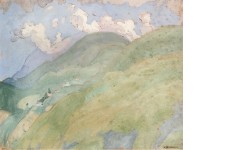TITΛΟΣ ΕΡΓΟΥΚΑΡΥΕΣ, ΙΒΙΡΙΚΑ ΜΟΝΑΣΤΗΡΙΑΚΑ ΚΕΛΛΙΑ
ΔΙΑΣΤΑΣΕΙΣ ΕΡΓΟΥΎψος : 28
Πλάτος : 34
ΥΛΙΚΟ ΚΑΤΑΣΚΕΥΗΣΕλαιογραφία (Λάδι σε χαρτί επικολλημένο σε καμβά)
ΥΠΟΓΡΑΦΗ ΚΑΛΛΙΤΕΧΝΗΚάτω Δεξιά
ΧΡΟΝΟΛΟΓΗΣΗ01-01-1923 - 01-01-1924
ΕΛΕΓΧΟΣ ΓΝΗΣΙΟΤΗΤΑΣΔεν έχει ελεγχθεί

Painted 1923-24
Provenance:
Acquired directly from the artists daughter Mina Papaloucas
Literature:
Spyros Papaloucas, Painting, Ioniki Bank, Athens 1995, p. 106 (illustrated)
Chrysanthos Christou, Mountainous Landscapes in Greek painting, Athens 1991, p.47 (illustrated)
Spyros Papaloucas, Days in Athos, Agra publications, Mount Athos 2003, no 3 (illustrated)
In early November 1923, Spyros Papaloukas, a true master of Greek landscape painting, went with his friend S. Doukas to Mt. Athos, where he stayed for a year, studying the untameable green.1 Among the works he completed during his stay, those inspired by expanded views of the arcadian landscape - a sea of green in which monasteries seem like vessels at anchor - comprise a distinct and very characteristic group (see also lot 94).
The precipitous and verdant mountains towering over the cells and monasteries, offered Papaloukas an ideal opportunity to exclude the horizon from most of his paintings. The acute luminosity of the Greek light, which clearly delineates even the remotest of mountains, justifies such an interpretation of space. By adhering to a solid compositional scheme and inner rhythm, Papaloukas rediscovers the natural continuum that underlies and binds all things together.2
Leading art critic E. Vakalo notes: Papaloukas Mt. Athos output is dominated by the study of the rhythm set by the dense chromatic volumes of the verdant flora in concert with the architectural elements of the monastic compounds. Many different approaches are evident. From the schematisation of form, which in the case of clouds - whenever a patch of sky is included - tends towards the decorative, to the successive and overlapping wooded planes which unfold as volumes, the direction of the brushstrokes that follows the movement of the forms, and the lower to higher perspective that follows the compositions ascending organization; generally the handling of the composition as a rhythm that develops towards the limits of the canvas.3
1. S. Doukas, Spyros Papaloukas, Zygos magazine no.31, May-June 1958, p. 7
2. M. Lambraki-Plaka, Papaloukas Painting in Spryros Papaloukas, Painting 1892-1957 [in Greek], ed. Ionian Bank, Athens 1995, pp. 37, 39
3. E. Vakalo, Papaloukas Painting in Spryros Papaloukas, Painting 1892-1957 [in Greek], ed. Ionian Bank, Athens 1995, pp. 150-151